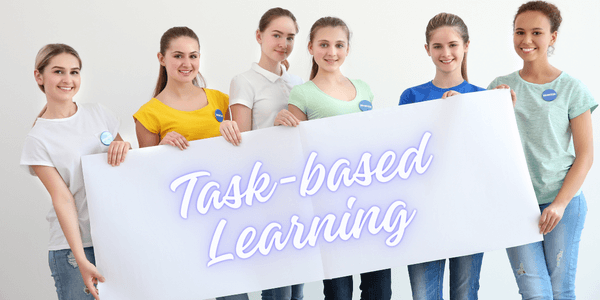Task Based Learning

- Noel Perera
- April 13, 2024
- 5:25 am
- No Comments
Task based learning – why do we need so many teaching approaches?
You need a hammer to pound a nail into wood. You need a saw to cut wood into pieces.
No single approach can answer all of learners’ difficulty.
From time, to time various types of teaching approaches have been introduced in order to address one or more issues learners deal with. However, it is likely that the approaches have some interesting relationships with each other. They overlap, support, complement and sometimes even contradict each other.
As no single approach is perfect, they all do share their own pros and cons.
Today, we are going to glance over one of the most common teaching approaches used in language teaching: Task Based Learning.
Task Based Learning - An Overview
Task-Based Learning (TBL) is an educational approach that emphasizes learning through doing. Here’s a quick overview at TBL in terms of its main focus, features, pros and cons, and two examples of its usage.
Main focus:
The main focus of TBL is on the completion of meaningful tasks that are relevant to real-world activities. It’s derived from Communicative Language Teaching (CLT) and puts tasks at the center of the learning process, aiming to promote the use of language as a tool for communication.
Features:
- Engagement in real-world tasks: Activities that people do in everyday life, such as creating a poster or designing a map.
- Goal-oriented activities: Tasks have clear outcomes or results.
- Assessment through task completion: Learners’ success is judged by their ability to complete the task.
- Incorporation of 4C’s: Communication, Collaboration, Creativity, and Critical Thinking are integral to TBL.
Pros:
- Motivation: Learners are often more motivated when tasks are interesting and relevant.
- Cooperation: Encourages teamwork and collaboration among learners.
- Meaningful interaction: Promotes authentic use of language through interaction.
- Learner experience: Builds on the previous knowledge and experience of learners.
Cons:
- Overemphasis on tasks: There’s a risk of focusing too much on task completion rather than language accuracy.
- Incomplete skill development: Performing tasks alone may not fully develop all communication skills.
- Potential for fossilization: Incorrect language use may become ingrained if not addressed properly.
Examples:
- Creating a Poster: Learners might work together to create a poster on a topic, using English to discuss and design it.
- Designing a map: Students could design a map of their school or neighborhood, describing it in English.

Task Based Learning - Things to Consider When Planning A Lesson
Let’s have a look at this lesson plan based on Task Based Learning (TBL).
The Lesson Title:
Let’s Go Shopping!
Objective(s):
By the end of this lesson, students will be able to:
1. Expand their vocabulary related to shopping.
2. Use language functions for shopping, such as asking for help, negotiating prices, and expressing preferences.
3. Engage in a role-play activity simulating a shopping scenario.
Materials Needed:
1. Flashcards or images of shopping-related items
2. Role-play cards with different shopping scenarios
3. Whiteboard and markers
4. Handouts with vocabulary and phrases related to shopping
5. Sample dialogues for reference
Stage 1: Introduction (5 minutes)
– Teacher introduces the topic of shopping and elicits from students what they already know about shopping vocabulary and functions.
– Teacher presents flashcards or images of different shopping items and asks students to guess their names.
– Teacher writes down new vocabulary on the board and elicits meanings and pronunciation from students.
Stage 2: Pre-task Preparation (10 minutes)
– Teacher provides handouts with vocabulary and phrases related to shopping and asks students to match them with their meanings.
– Teacher models pronunciation and drills key phrases with the class.
– Students practice using the phrases in pairs or small groups.
Stage 3: Task Phase (20 minutes)
– Teacher divides students into pairs or small groups.
– Each group receives a role-play card with a different shopping scenario (e.g., buying clothes, groceries, electronics).
– Students role-play the scenarios, using the vocabulary and phrases they have learned.
– Teacher monitors and provides support as needed.
Stage 4: Task Evaluation and Feedback (10 minutes)
– After the role-play activity, the teacher facilitates a class discussion where students share their experiences and challenges during the task.
– Teacher provides feedback on language use, pronunciation, and communication strategies.
– Teacher highlights successful language use and addresses common errors or areas for improvement.
Stage 5: Language Focus (10 minutes)
– Based on observations during the task phase and feedback session, the teacher identifies specific language points that need further clarification or practice.
– Teacher conducts focused language activities or drills to reinforce these points.
– Students engage in practice exercises related to grammar, vocabulary, or pronunciation as needed.
Stage 6: Conclusion and Extension (5 minutes)
– Teacher summarizes the key vocabulary and language functions learned during the lesson.
– Students are encouraged to apply what they have learned outside the classroom, such as during real-life shopping experiences or through online shopping simulations.
– Teacher assigns homework, which may include reviewing vocabulary or practicing dialogues.
Now let’s go through each stage analysing TBL in action.
Stage 1:
The introduction phase involves setting the context and introducing vocabulary, which supports the main task of the lesson.
Stage 2:
This phase focuses on preparing students with the necessary language skills and knowledge to complete the main task effectively.
Stage 3:
This Task phase involves students engaging in the main task, which is a realistic and meaningful activity related to the target language.
Stage 4:
This stage encourages students to reflect on their performance and receive feedback, which helps them improve their language skills for future tasks.
Stage 5:
This Language Focus stage allows for targeted language instruction based on the needs identified during the task phase, ensuring that students can apply new language knowledge in context.
Stage 6:
This phase encourages students to transfer their learning to real-life situations beyond the classroom, promoting authentic language use and application.
Task-based learning offers advantages to students as it prioritizes a student-centered approach, facilitating more meaningful communication and often incorporating practical non-language skill development. Since the tasks are typically familiar to students, such as doing shopping, they are more likely to be actively engaged, which can enhance their motivation in language learning.

Noel Perera
Admin/Trainer - TKT Cambridge
Noel is passionate about helping new teachers develop their skills and advance their careers. He has worked with hundreds of TKT candidates from around the world, helping them prepare for the exam and improve their teaching techniques. TKT Cambridge is a repository of his knowledge and expertise acquired over 18+ years of his career as an English teacher and trainer.
